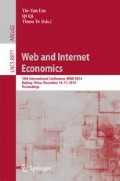Abstract
A recent line of work, starting with Beigman and Vohra [4] and Zadimoghaddam and Roth [30], has addressed the problem of learning a utility function from revealed preference data. The goal here is to make use of past data describing the purchases of a utility maximizing agent when faced with certain prices and budget constraints in order to produce a hypothesis function that can accurately forecast the future behavior of the agent.
In this work we advance this line of work by providing sample complexity guarantees and efficient algorithms for a number of important classes. By drawing a connection to recent advances in multi-class learning, we provide a computationally efficient algorithm with tight sample complexity guarantees (\(\tilde{\Theta}(d/\epsilon)\) for the case of d goods) for learning linear utility functions under a linear price model. This solves an open question in Zadimoghaddam and Roth [30]. Our technique yields numerous generalizations including the ability to learn other well-studied classes of utility functions, to deal with a misspecified model, and with non-linear prices.
Access this chapter
Tax calculation will be finalised at checkout
Purchases are for personal use only
Preview
Unable to display preview. Download preview PDF.
References
Afriat, S.N.: The construction of utility functions from expenditure data. International Economic Review (1967)
Balcan, M.F., Daniely, A., Mehta, R., Urner, R., Vazirani, V.V.: Learning economic parameters from revealed preferences (2014), http://arxiv.org/abs/1407.7937
Bazarra, M.S., Sherali, H.D., Shetty, C.M.: Nonlinear Programming: Theory and Algorithms. John Wiley & Sons (2006)
Beigman, E., Vohra, R.: Learning from revealed preference. In: EC, pp. 36–42 (2006)
Boyd, S., Vandenberghe, L.: Convex Optimization. Cambridge University Press (2009)
Collins, M.: Discriminative reranking for natural language parsing. In: ICML, pp. 175–182 (2000)
Collins, M.: Discriminative training methods for hidden markov models: Theory and experiments with perceptron algorithms. In: Proceedings of the ACL 2002 Conference on Empirical Methods in Natural Language Processing, EMNLP 2002, vol. 10, pp. 1–8. Association for Computational Linguistics, Stroudsburg (2002)
Crammer, K., Singer, Y.: On the algorithmic implementation of multiclass kernel-based vector machines. Journal of Machine Learning Research 2, 265–292 (2001)
Daniely, A., Shalev-Shwartz, S.: Optimal learners for multiclass problems. In: COLT, pp. 287–316 (2014)
Diewert, E.: Afriat and revealed preference theory. Review of Economic Studies 40, 419–426 (1973)
Dobell, A.R.: A comment on A. Y. C. Koo’s an empirical test of revealed preference theory. Econometrica 33(2), 451–455 (1965)
Echenique, F., Golovin, D., Wierman, A.: A revealed preference approach to computational complexity in economics. In: EC, pp. 101–110 (2011)
Haussler, D., Welzl, E.: Epsilon-nets and simplex range queries. In: Symposium on Computational Geometry, pp. 61–71 (1986)
Houthakker, H.S.: Revealed preference and the utility function. Economica 17, 159–174 (1950)
Koo, A.Y.C.: An empirical test of revealed preference theory. Econometrica 31(4), 646–664 (1963)
Lafferty, J.D., McCallum, A., Pereira, F.C.N.: Conditional random fields: Probabilistic models for segmenting and labeling sequence data. In: ICML, pp. 282–289 (2001)
Lahaie, S.: Kernel methods for revealed preference analysis. In: European Conference on Artificial Intelligence, pp. 439–444 (2010)
Littlestone, N., Warmuth, M.K.: Relating data compression and learnability. Unpulished manuscript (1986)
Mas-Colell, A.: The recoverability of consumers’ preferences from market demand. Econometrica 45(6), 1409–1430 (1977)
Mas-Colell, A.: On revealed preference analysis. The Review of Economic Studies 45(1), 121–131 (1978)
Mas-Colell, A., Whinston, M.D., Green, J.R.: Microeconomic Theory. Oxford University Press, New York (1995)
Natarajan, B.: On learning sets and functions. Machine Learning 4(1), 67–97 (1989)
Richter, M.: Revealed preference theory. Econometrica 34(3), 635–645 (1966)
Samuelson, P.: Consumption theory in terms of revealed preference. Econometrica 15 (1948)
Shalev-Shwartz, S., Ben-David, S.: Understanding Machine Learning. Cambridge University Press (2014)
Uzawa, H.: Preference and rational choice in the theory of consumption. In: Arrow, K.J., Karlin, S., Suppes, P. (eds.) Mathematical Models in Social Science (1960)
Valiant, L.G.: A theory of the learnable. Commun. ACM 27(11), 1134–1142 (1984)
Varian, H.R.: The non-parametric approach to demand analysis. Econometrica 50, 945–974 (1982)
Varian, H.R.: Revealed preference. In: Szenberg, M., Ramrattand, L., Gottesman, A.A. (eds.) Samuelsonian Economics and the 21st Century, pp. 99–115 (2005)
Zadimoghaddam, M., Roth, A.: Efficiently learning from revealed preference. In: Goldberg, P.W. (ed.) WINE 2012. LNCS, vol. 7695, pp. 114–127. Springer, Heidelberg (2012)
Author information
Authors and Affiliations
Editor information
Editors and Affiliations
Rights and permissions
Copyright information
© 2014 Springer International Publishing Switzerland
About this paper
Cite this paper
Balcan, MF., Daniely, A., Mehta, R., Urner, R., Vazirani, V.V. (2014). Learning Economic Parameters from Revealed Preferences. In: Liu, TY., Qi, Q., Ye, Y. (eds) Web and Internet Economics. WINE 2014. Lecture Notes in Computer Science, vol 8877. Springer, Cham. https://doi.org/10.1007/978-3-319-13129-0_28
Download citation
DOI: https://doi.org/10.1007/978-3-319-13129-0_28
Publisher Name: Springer, Cham
Print ISBN: 978-3-319-13128-3
Online ISBN: 978-3-319-13129-0
eBook Packages: Computer ScienceComputer Science (R0)

